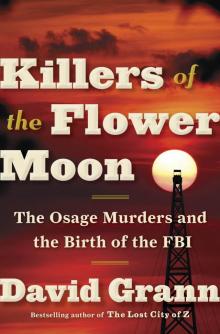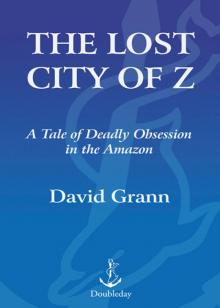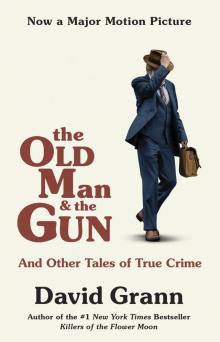- Home
- David Grann
Killers of the Flower Moon Page 3
Killers of the Flower Moon Read online
Page 3
Mollie pressed the authorities to investigate Anna’s murder, but most officials seemed to have little concern for what they deemed a “dead Injun.” So Mollie turned to Ernest’s uncle, William Hale. His business interests now dominated the county, and he had become a powerful local advocate for law and order—for the protection of what he called “God-fearing souls.”
Hale, who had an owlish face, stiff black hair, and small, alert eyes set in shaded hollows, had settled on the reservation nearly two decades earlier. Like a real-life version of Faulkner’s Thomas Sutpen, he seemed to have come out of nowhere—a man with no known past. Arriving in the territory with little more than the clothes on his back and a worn Old Testament, he embarked on what a person who knew him well called a “fight for life and fortune” in a “raw state of civilization.”
Hale found work as a cowboy on a ranch. Before trains crisscrossed the West, cowboys drove cattle from Texas to Osage territory, where the herds grazed on the lush bluestem grass, and then on to Kansas, for shipment to slaughterhouses in Chicago and other cities. These drives fueled the American fascination with cowboys, but the work was hardly romantic. Hale toiled day and night for a pittance; he rode through storms—hail, lightning, sand—and survived stampedes, guiding the cattle into smaller and smaller circles before they could trample him. His clothes carried the stench of sweat and manure, and his bones were frequently battered, if not broken. Eventually, he hoarded and borrowed enough money to buy his own herd in Osage territory. “He is the most energetic man I ever knew,” a man who invested in his business recalled. “Even when he crossed the street he walked as if he were going after something big.”
Hale soon went bankrupt—an embittering failure that only stoked the furnace of his ambition. After he started over in the cattle business again, he often slept in a tent on the cold windy plains, alone in his fury. Years later, a reporter described how he’d still pace before a fire “like a leashed animal. He nervously rubbed his hands into the flames. His rather ruddy face was aglow with cold and excitement.” He worked with the fever of someone who feared not only hunger but an Old Testament God who, at any moment, might punish him like Job.
He became an expert at branding, dehorning, castrating, and selling stock. As his profits rose, he bought up more territory from the Osage and neighboring settlers until he had amassed some forty-five thousand acres of the finest grazing land in the county, as well as a small fortune. And then, in that uncanny American way, he went to work on himself. He replaced his ragged trousers and cowboy hat with a dandified suit and a bow tie and a felt hat, his eyes peering out through distinguished round-rimmed glasses. He married a schoolteacher and had a daughter who adored him. He recited poetry. Pawnee Bill, the legendary Wild West showman and the onetime partner of Buffalo Bill, described Hale as a “high-class gentleman.”
He was named a reserve deputy sheriff in Fairfax, a position that he would continue to hold. The title was largely honorific, but it enabled him to carry a badge and to lead posses, and he sometimes kept one pistol in his side pocket and another strapped to his hip. They represented, he liked to say, his authority as an officer of the law.
As his wealth and power grew, politicians courted his support, knowing that they couldn’t win without his blessing. He outworked and outwitted his rivals, making plenty of enemies who wanted him dead. “Some did hate him,” a friend admitted. Still, Mollie Burkhart and many others considered him Osage County’s greatest benefactor. He aided the Osage before they were flush with oil money, donating to charities and schools and a hospital. Assuming the mantle of a preacher, he signed his letters “Rev. W. K. Hale.” A local doctor said, “I couldn’t begin to remember how many sick people have received medical attention at his expense, nor how many hungry mouths have tasted of his bounty.” Later, Hale wrote a letter to an assistant chief of the tribe, saying, “I never had better friends in my life than the Osages….I will always be the Osages true Friend.” In this last remnant of the American frontier, Hale was revered as the “King of the Osage Hills.”
William Hale competing in a roping contest when he was a cowboy Credit 7
A transformed Hale standing with his daughter and wife Credit 8
Hale frequently came by Mollie’s house to collect Ernest, and not long after Anna’s burial Hale showed up to pay his respects to Mollie and her mother. He vowed to obtain justice for Anna.
With his supreme confidence and his mastery of that secret world of whites (he often wore a diamond-studded pin from the Masonic lodge), it didn’t seem to matter that he had no formal role in the murder investigation. He had always expressed affection for Anna—“We were mighty good friends,” he said—and during another visit Mollie could see him huddled with Ernest, apparently talking about hunting down whoever had murdered her sister.
Members of the coroner’s inquest, along with the county prosecutor, continued investigating Anna’s death, and shortly after Anna’s burial Mollie went to give evidence at a hearing in Fairfax. The Department of the Interior’s Office of Indian Affairs—which oversaw government relations with tribes and was later renamed the Bureau of Indian Affairs—had a field agent assigned to the Osage territory who knew Mollie. He said that she was “willing to do everything she can in order to…bring the guilty parties to justice.” The authorities had provided a translator for Mollie, but she waved him off and spoke in succinct English, the way the nuns had taught her as a child.
Mollie described for the jurors the final time that Anna visited her house. She said that Anna had left around sundown. In a later proceeding, a government official asked her, “How did she go?”
“She goes in a car.”
“Who was with her?”
“Bryan Burkhart.”
“Did you notice which direction they went?”
“Towards Fairfax.”
“Was anyone else in the car with Bryan and Anna?”
“No, just Bryan and Anna…”
“Did you see her any more alive after that?”
Mollie stayed composed. “No,” she said.
“You saw her body after it was found?”
“Yes.”
“How long was it about after this time you saw her leave your mother’s place with Bryan Burkhart, you saw her body?”
“About five or six days.”
“Where did you see the body?”
“At the pasture…just right there.”
At the inquest, while Mollie seemed eager to answer every question, to make sure that nothing was missed, the justice of the peace and the jurors asked her barely anything. Perhaps they discounted her because of prejudice—because she was an Osage and a woman. The panel questioned with greater depth Bryan Burkhart, about whom many locals had begun to whisper; after all, he was the last person seen with Anna before she went missing.
Bryan lacked the good looks of his brother Ernest, Mollie’s husband, and there was something cold about his appearance; he had uncomfortably steady eyes. Hale had once caught him stealing his cattle and, to teach his nephew a lesson, filed charges against him.
The county prosecutor asked Bryan about the day that he said he’d given Anna a ride to her house. “When you brought her back, where did you go?”
“Come to town.”
“When was this?”
“About 5 or 4:30.”
“You haven’t seen her since then?”
“No, sir.”
At one point, the county prosecutor paused and asked, “Positive?”
“Yes, sir.”
At a later hearing, Ernest was also questioned. A law-enforcement official pressed him about his brother: “You understand he is the last person seen with this woman, Anna Brown?”
“I understand,” Ernest replied, adding that Bryan told him “he left her at her house. That is his story.”
“Do you believe it?”
“Yes, sir.”
Bryan was detained by the authorities after the first hearing. To Mollie’s dis
tress, they even held Ernest, too, in case he was covering for his younger brother. But both men were soon turned loose. There was no evidence implicating Bryan other than the fact that he’d been with Anna before she disappeared. When Ernest was asked if he had any information as to how Anna met her death, he said no, adding, “I don’t know of enemies she had or anyone that disliked her.”
A prevailing theory was that her killer came from outside the reservation. Once, the tribe’s enemies had battled them on the plains; now they came in the form of train robbers and stickup men and other desperadoes. The passage of Prohibition had only compounded the territory’s feeling of lawlessness by encouraging organized crime and creating, in the words of one historian, “the greatest criminal bonanza in American history.” And few places in the country were as chaotic as Osage County, where the unwritten codes of the West, the traditions that bound communities, had unraveled. By one account, the amount of oil money had surpassed the total value of all the Old West gold rushes combined, and this fortune had drawn every breed of miscreant from across the country. A U.S. Justice Department official warned that there were more fugitives hiding out in the Osage Hills than “perhaps any other county in the state or any state in the Union.” Among them was the hard-boiled stickup man Irvin Thompson, who was known as Blackie maybe because of his dark complexion (he was a quarter Cherokee) or maybe because of his dark heart: a lawman described him as “the meanest man I ever handled.” Even more notorious was Al Spencer, the so-called Phantom Terror, who had made the transition from galloping horses to speeding getaway cars and had inherited from Jesse James the title of the region’s most infamous outlaw. The Arizona Republican said that Spencer, with his “diseased mind and a misguided love of adventure,” appealed to the “portion of the population of the country that fed on false idolatry.” Members of his gang, including Dick Gregg and Frank “Jelly” Nash, were themselves ranked among the most dreaded outlaws of the day.
Lawmen seize a moonshine still in Osage County in 1923. Credit 9
Al Spencer Gang members jokingly hold up others in their crew. Credit 10
A more unnerving theory about Anna’s death was that her killer was living among them in sheep’s clothing. Mollie and others began to harbor suspicions about Anna’s ex-husband, Oda Brown, who called himself a businessman but spent most of his time carousing. In retrospect, his distraught manner had seemed almost too theatrically intense. An investigator wrote in his notes, “This may have been real grief or…for effect.” After Anna had divorced him, she had denied him any inheritance, leaving virtually all of her fortune to Lizzie. Since the burial, Brown had hired a lawyer and had tried unsuccessfully to contest the will. The investigator concluded that Brown was “absolutely no good and capable of doing almost anything for money.”
Several weeks after the funeral, a man who’d been arrested in Kansas for check forgery sent a letter to Sheriff Freas claiming that he had information concerning Anna’s murder. “Honorable Sir,” he wrote, “I hope to be some assistance to you.” He didn’t divulge what he knew, however, and upon receiving the message the sheriff set out in what the press described as a “fast automobile.” Hale, who had been tipped off regarding the potential breakthrough, rushed to the jail as well. Under interrogation, the forger, a fidgety twenty-eight-year-old man, claimed that Brown had paid him $8,000 to murder Anna. He described how he’d shot her in the head, then carried her body in his arms down to the creek.
Soon after his confession, a posse of lawmen swept in and seized Brown when he was in Pawhuska on business. The Pawhuska Daily Capital heralded the news: ANNA BROWN SLAYER CONFESSES CRIME. It added, “Oda Brown, Husband of Woman, Also Arrested.” Mollie and her family were devastated by the notion that Oda was responsible for Anna’s murder, but they could take solace in the thought of his facing justice, perhaps the hangman’s noose or the electric chair. But within days authorities had conceded that there was no evidence to support the forger’s claims—no evidence that he had been in Osage County at the time of the murder or that Brown had ever contacted him. The authorities had no choice but to release Brown. “There’s a lot of talk,” the sheriff was quoted as saying. “But you have to have proof, not talk.”
Like many officials, the county prosecutor owed his election at least in part to Hale. When he first ran for office, his advisers told him that he had to get Hale’s endorsement, and so he made several trips to Hale’s ranch. He could never find him, and finally a cattle inspector told him, “If you want to see Bill Hale, you will have to get to his ranch early—and I mean damned early.” So, at three in the morning, the attorney parked his Model T at the ranch and went to sleep in the car. Before long, he was jolted awake by a fierce-looking man pressed against his window, demanding to know why he was trespassing. It was William Hale. The attorney explained his purpose, and Hale realized that he knew the attorney’s parents, who had once sheltered him during a blizzard. Hale promised to turn out the vote for him. One of the attorney’s advisers remarked that Hale “would not lie to anyone, and if he said he would do something, he would do it.” On Election Day, the attorney carried every single precinct in that part of the county.
Hale had remained close with the county prosecutor and conferred with him and other officials about Anna’s murder. Eventually, the county prosecutor decided to look again for the bullet that had eluded investigators during Anna’s autopsy. A court order was obtained to unbury Anna. Scott Mathis, the Big Hill Trading Company owner who was friends with Hale and Mollie, was asked to supervise the grim task, and he went to the cemetery with his undertaker and a grave digger. The grass on Anna’s plot had barely had time to grow back. The men began to prod the unforgiving earth with their spades, then reached down and lifted up the once white casket, now dirt blackened, and forced open the lid. An awful vapor, death itself, filled the air.
The Shoun brothers, who had performed the first autopsy, appeared at the cemetery and renewed their search for the bullet. This time, the brothers put on gloves and took out a meat cleaver, cutting Anna’s head into “sausage meat,” as the undertaker later put it. But, once again, the brothers found nothing. The bullet appeared to have vanished.
By July 1921, the justice of the peace had closed his inquiries, stating that Anna Brown’s death had come at “the hands of parties unknown”—the same finding as delivered in the Whitehorn inquest. The justice locked away in his office the little evidence that he’d gathered, in case more information emerged.
Meanwhile, Lizzie—who’d once possessed the same energy and stubborn determination as Mollie—had grown sicker. Each day, she seemed to drift further away, to become more insubstantial; it was as if she had the same peculiar wasting illness that had consumed Minnie.
Desperate for help, Mollie turned to the Osage medicine men, who chanted when the eastern sky was red like blood, and to the new breed of medicine men, the Shoun brothers, who carried their potions in black bags. Nothing seemed to work. Mollie kept vigil over her mother, one of the last tethers to the tribe’s ancient way of life. Mollie could not cure her, but she could feed her, and she could brush her long, beautiful, silvery hair from her face—a face that was lined and expressive, that maintained its aura.
One day that July, less than two months after Anna’s murder, Lizzie stopped breathing. Mollie couldn’t revive her. Lizzie’s spirit had been claimed by Jesus Christ, the Lord and Savior, and by Wah’Kon-Tah, the Great Mystery. Mollie was overwhelmed with grief. As an Osage mourning prayer went,
Have pity on me, O Great Spirit!
You see I cry forever,
Dry my eyes and give me comfort.
Mollie’s brother-in-law, Bill Smith, was one of the first to wonder if there was something curious about Lizzie’s death, coming so soon after the murders of Anna and Whitehorn. A bruising bulldog of a man, Bill had also expressed deep frustration over the authorities’ investigation, and he had begun looking into the matter himself. Like Mollie, he was struck by the peculiar vaguen
ess of Lizzie’s sickness; no doctor had ever pinpointed what was causing it. Indeed, no one had uncovered any natural cause for her death. The more Bill delved, conferring with doctors and local investigators, the more he was certain that Lizzie had died of something dreadfully unnatural: she’d been poisoned. And Bill was sure that all three deaths were connected—somehow—to the Osage’s subterranean reservoir of black gold.
4 UNDERGROUND RESERVATION
The money had come suddenly, swiftly, madly. Mollie had been ten years old when the oil was first discovered, had witnessed, firsthand, the ensuing frenzy. But, as the elders in the tribe had relayed to Mollie, the tangled history of how their people had gotten hold of this oil-rich land went back to the seventeenth century, when the Osage had laid claim to much of the central part of the country—a territory that stretched from what is now Missouri and Kansas to Oklahoma, and still farther west, all the way to the Rockies.
In 1803, President Thomas Jefferson purchased, from the French, the Territory of Louisiana, which contained lands dominated by the Osage. Jefferson informed his secretary of the navy that the Osage were a great nation and that “we must stand well, because in their quarter we are miserably weak.” In 1804, a delegation of Osage chiefs met with Jefferson at the White House. He told the navy secretary that the Osage, whose warriors typically stood well over six feet tall, were the “finest men we have ever seen.”

 The Devil & Sherlock Holmes: Tales of Murder, Madness & Obsession
The Devil & Sherlock Holmes: Tales of Murder, Madness & Obsession Killers of the Flower Moon
Killers of the Flower Moon The Lost City of Z
The Lost City of Z The Old Man and the Gun
The Old Man and the Gun